1988 PONTIAC FIERO relay
[x] Cancel search: relayPage 1515 of 1825

Continued from previous page)
Note: VVhen the PASSKEY Decoder Module
is replaced, the new key code may not
match the code in the owner's existing
keys. If it does not match, then new
keys must be made. Use the key
duplication procedure.
1. Check YEL (921) and BRN (922) wires for
shorts to ground or between the two
wires.
2. Check
UEL (921) and BRN (922) wires for
an open. If
engine does not crank, go to page 30-0 for
diagnosis of Starter and Charging Circuits.
C3. Reconnect the Starter Enable Relay and
connect a fused jumper from terminal A3
(DK GRN) wire of the PASSKEY Decoder
Module to ground. Ignition Switch to
START.
0 If engine cranks, replace the PASSKEY
Decoder Module.
If engine does not crank, check the DK
GRN (965) wire for
an open. If wire is OK,
replace the Starter Enable Relay.
6: STARTER ENABLE RELAY TEST
D: ECM ENABLE SIGNAL TEST
C2. Connect a fused jumper between terminals
Measure: VOLTAGE
At: STARTER ENABLE RELAY CONNECTOR
(Disconnected)
Condition:
0 Ignition Switch: START Measure:
VOLTAGE
At: PASSKEY DECODER MODULE
CONNECTOR (Connected)
Condition: 0 Ignition Switch: RUN
Measure
Between
&
Ground
&
Ground
Measure
Between I I For Diagnosis ( Voltage
1 I 5Volts I See 1 1
If voltages are correct, go to C2.
1. Check YEL (5) wire for an open. If wire is
good but voltage is not present, go to
8A-30 for diagnosis of Starter and Charg-
ing Circuits.
Correct
Voltage
Battery
Battery
I I
Ignition Switch: START
For Diagnosis
See 1
See 1
0 wait four minutes from last time Ignition
Switch was turned to OFF to
allow PAS-
SKEY Internal timer to reset.
I A2 IPPL)& ) 2 to3Volts I See2 i Ground
If voltages are correct, cranking Fuel
Enable signal is operating normally,
return to Symptom Table.
E (YEL) Vfire and A (DK GR wire 1 1. Check PPL (963) wire for an open. A of the Starter Enable Relay Connector. I I
(Continued in next column)
Ignition Switch to START.
If engine cranks proceed to
63.
Continued from previous column)
2. Replace PASSKEY Decoder Module.
Note: When the PASSKEY Decoder Module
is replaced, the key code
it is set for
may not match the code in the owner's
keys. If
it does not, then new keys
must be made. Use the procedure
under
Duplicgti~n of-Keys2
E: SECURITY INDICATOR OPEN TEST
CONNECTOR (Disconnected)
Condition:
KEY DUPLICATION PROCEDURE
Key Replacement (Spare Key Available)
The 535628 Interrogator or equivalent must
be used to det e
the proper electrical code
of the key.
1. Insert the customer's spare ignition key into
the Key Code Reader on the 535628 Inter-
rogator.
2. Press the On-Off rocker switch to the ON
position.
Page 1516 of 1825
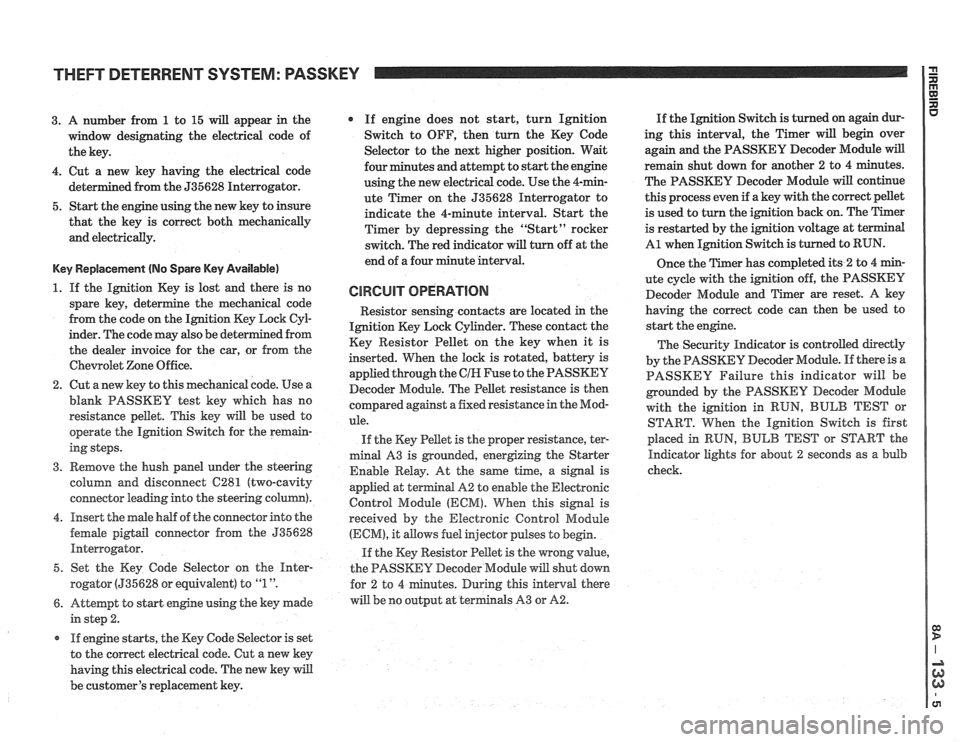
THEFT DETERRENT SYSTEM: PASSKEY
3. A number from 1 to 15 will appear in the
window designating the electrical code of
the key.
4. Cut a new key having the electrical code
ed from the 535628 Interrogator.
5. Start the engine using the new key to insure
that the key is correct both mechanically
and electrically.
Key Replacement (No Spare Key Available)
1. If the Ignition Key is lost and there is no
spare key, determine the mechanical code
from the code on the Ignition Key Lock
CyE
inder. The code may also be det
the dealer invoice for the car, or from the
Chewolet Zone Office.
2. Cut anew key to this mechanical code. Use a
blank PASSKEY test key which has no
resistance pellet. This key will be used to
operate the Ignition Switch for the remain-
ing steps.
3. Remove the hush panel under the steering
column and disconnect
C281 (two-cavity
connector leading into the steering column).
4. Insert the male half of the connector into the
female
pigtail connector from the 535628
Interrogator.
5. Set the Key Code Selector on the
Hnter-
rogator (535628 or equivalent) to "1 ".
6. Attempt to start engine using the key made
in step 2.
r If engine starts, the Key Code Selector is set
to the correct electrical code. Cut a new key
having this electrical code. The new key will
be customer's replacement key.
If engine does not start, turn Ignition
Switch to OFF, then turn the Key Code
Selector to the next higher position. Wait
four minutes and attempt to start the engine
using the new electrical code. Use the 4-min-
ute Timer on the 535628 Interrogator to
indicate the 4-minute interval. Start the
Timer by depressing the "Start" rocker
switch. The red indicator
will turn off at the
end of a four minute interval.
CIRCUIT OPERATION
Resistor senshg contacts are located in the
Ignition Key Lock Cylinder. These contact the
Key Resistor Pellet on the key when it is
inserted. When the lock is rotated, battery is
applied through the
CIH Fuse to the PASSKEY
Decoder Module. The Pellet resistance is then
colnpared against a fixed resistance in the Mod-
ule.
If the Key Pellet is the proper resistance, ter-
minal A3 is grounded, energizing the Starter
Enable Relay. At the
same time, a signal is
appfied at terminal A2 to enable the Electronic
Control Module
(ECM). When this signal is
received by the Electronic Control Module
(ECM), it allows fuel injector pulses to begin.
If the Key Resistor Pellet is the wrong
value,
the PASSKEY Decoder Module will shut down
tes. During this interval there
will be no output at terminals A3 or
A2.
If the Ignition Switch is turned on again dur-
ing this interval, the Timer will begin over
again and the PASSKEY Decoder Module
will
remain shut down for another 2 to 4 minutes.
The PASSKEY Decoder Module will continue
this process even if a key with the correct pellet
is used to turn the ignition back on. The Timer
is restarted by the ignition voltage at
t
A1 when Ignition Switch is turned to RUN.
Once the Timer has completed its
2 to 4 min-
ute cycle with the ignition off, the PASSKEY
Decoder Module and Timer are reset. A key
having the correct code can then be used to
start the engine.
The Security Indicator is controlled directly
by the PASSKEY Decoder Module. If there is a
PASSKEY Failure this indicator will be
grounded by the PASSKEY
Decoder Module
with the ignition in RUN,
BULB TEST or
START. When the Ignition Switch is first
placed in
RUN, BULB TEST or START the
Indicator lights for about 2 seconds as a bulb
check.
Page 1519 of 1825
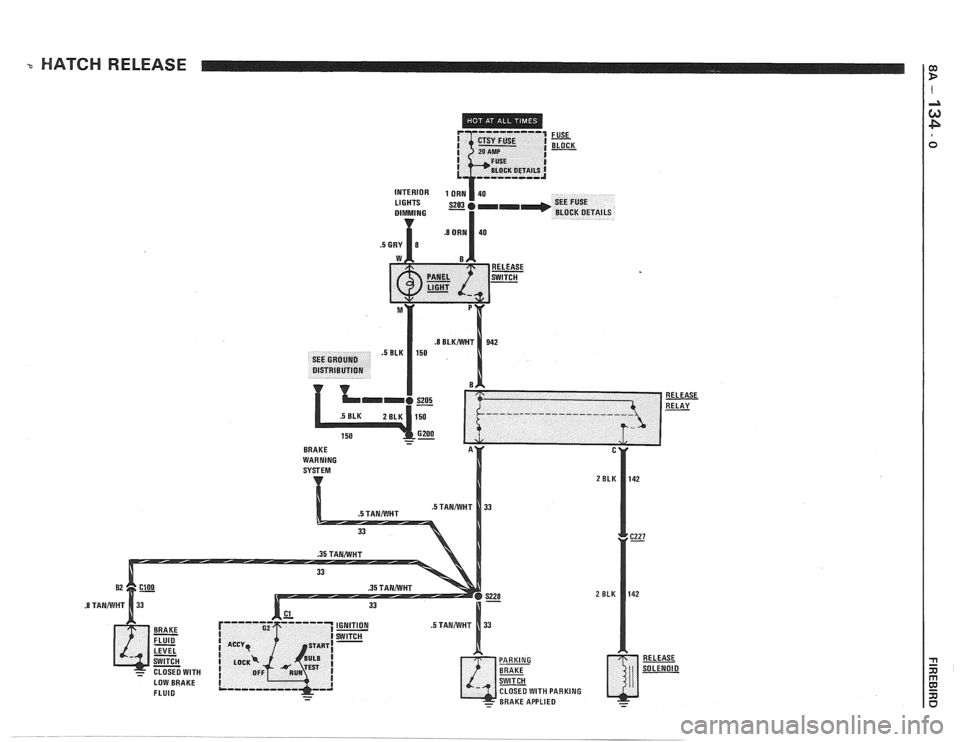
a HATCH RELEASE
RELEASE
RELAY
BRAKE
WARNING SYSTEM
I
CLOSED WITH PARKING - BRAKE APPLIED -
Page 1520 of 1825

HATCH RELEASE P
E
TROUBLESHOOTING H lNTS
0 Try the following checks before doing the
System Diagnosis.
1. Check the CTSY Fuse by operating the
Radio.
2. Check that the Hatch Release Solenoid
case ground is clean and tight.
3. Check the Parking Brake Switch by apply-
ing Parking Brake with Ignition Switch in
RUN and observing the BRAKE Indicator.
@ Go to System Check for a guide to normal
operation.
Go to System Diagnosis for diagnostic tests.
SYSTEM CHECK -
o Use the System Check fable as a guide to
normal operation.
SYSTEM CHECK TABLE
lease button with
SYSTEM DIAGNOSIS
e Do the tests below if the Hatch Release
does not operate properly.
COMPONENT LOCATION Page-Figure
Brake Fluid Level Switch. ......... Below brake fluid reservoir ..................
Fuse Block. ..................... Behind LN side of IIP, below light switch. ......
Ignition Switch. ................. Behind IIP, on top side of steering column ......
Parking Brake Switch. ............ In console, at base of parking brake ...........
Release Relay ................... Taped to IIP harness, behind RN side of IIP. ....
Release Solenoid ................. On center of end panel ......................
el00 (42 cavities) ................ LN front of dash, left of brake master cylinder ..
C227 (1 cavity) .................. Behind LN side of IIP, at shroud
6200
.......................... Behind IIP, left of steering c
S203. .......................... IIP harness, behind instrunnent cluster. ........
.......................... ........ S205. IIP harness, behind instrument cluster.
S228. .......................... IIP harness, above Fuse Block. ...............
WATGH RELEASE TEST (TABLE 1)
At: RELEASE SOLENOID CONNECTOR
(Disconnected)
I 0 Parkina Brake: APPLIED I
I Measure I Correct I For
(Continued from previous column)
BLK & 1 o volts I See I 1 Ground
I r Hatch Release button pressed I --
(Continued in next column)
(Continued on next page)
Page 1521 of 1825
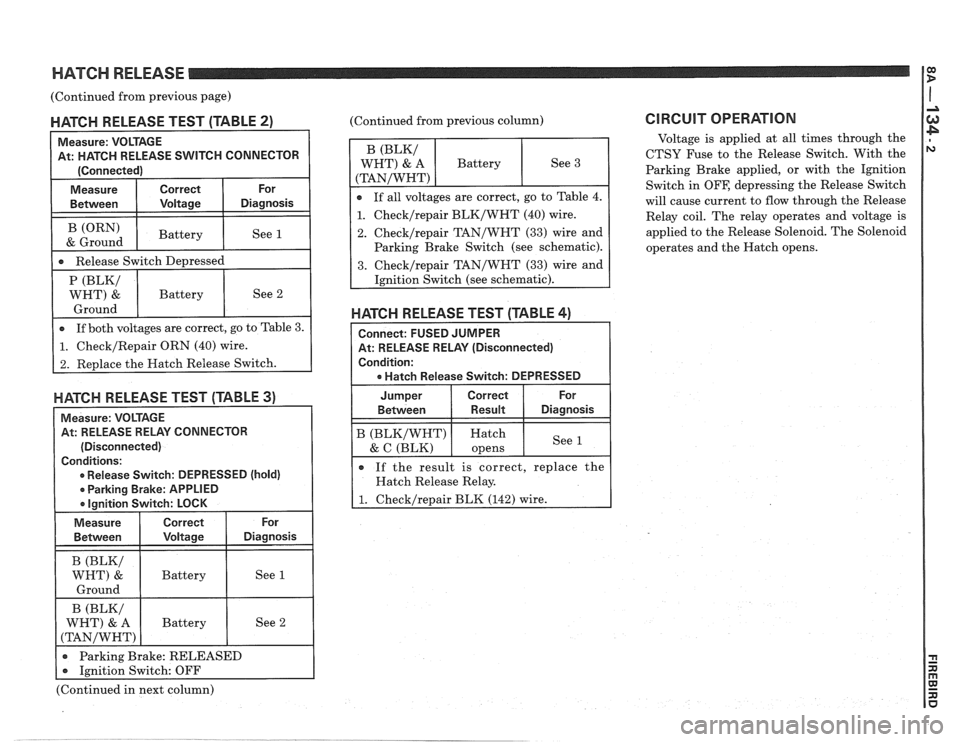
HATCH RELEASE 1:
(Continued from previous page) I
MATGH RELEASE TEST (TABLE 2)
Measure: VOLTAGE
At: HATCH RELEASE
SVVITCH CONNECTOR
[Connected)
-re I Correct I or I
Between I Voltage I Diagnosis I I
1 -a Release Switch De~ressed I
(ORN)
& Ground
HAKH RELEASE TEST (TABLE 3)
Measure: VOLTAGE
At: RELEASE RELAY CONNECTOR
(Disconnected)
Conditions:
0 Release Switch: DEPRESSED (hold)
r Parking Brake: APPLIED
a lanition Switch: LOCK
Battery (Continued from
previous column)
See 1
1. Checklrepair BLK/WHT (40) wire.
2. Checklrepair TAN/WHT (33) wire and
Parking Brake Switch (see schematic).
HATGH RELEASE TEST (TABLE 4)
Connect: FUSED JUMPER
At: RELEASE RELAY (Disconnected)
Condition:
a Hatch Release Switch: DEPRESSED
Jumper Correct For
Between Result Diagnosis
B (BLKIWHT) Hatch
& C (BLK) See 1 opens
e If
the result is correct, replace the
Hatch Release Relay.
1. Checklrepair BLK (142) wire.
CIRCUIT OPERATION
Voltage is applied at all times through the
CTSY Fuse to the Release Switch. With the
Parking Brake applied, or with, the Ignition
Switch in
OFF, depressing the Release Switch
will cause current to flow through the Release
Relay coil. The relay operates and voltage is
applied to the Release Solenoid. The Solenoid
operates and the Hatch opens.
(Continued in next column)
Page 1535 of 1825
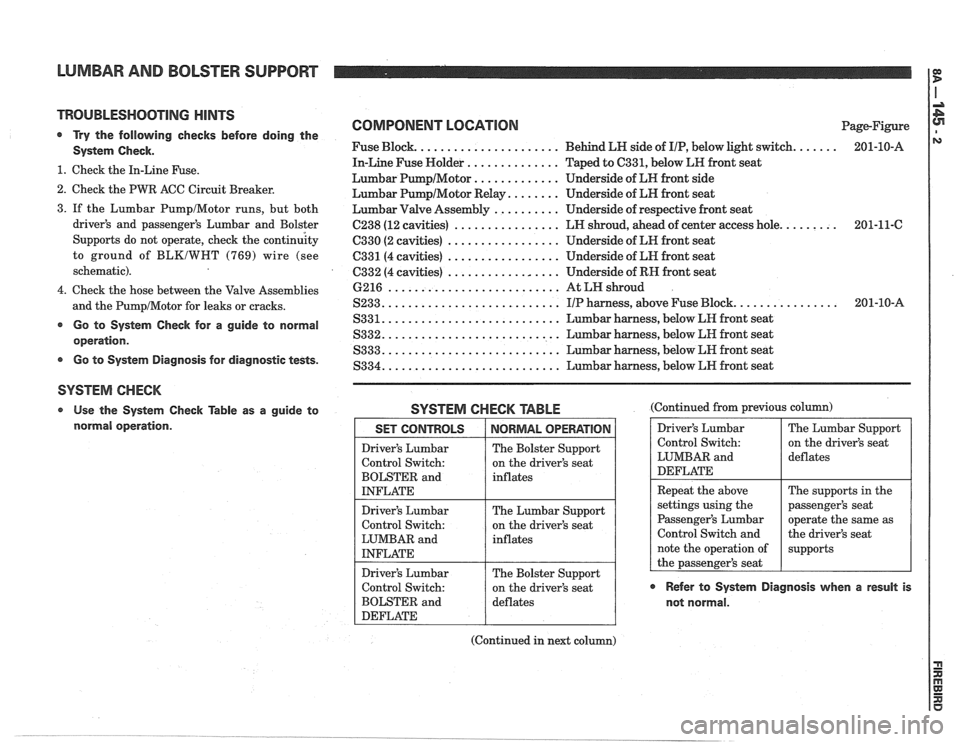
LUMBAR AND BOLSTER SUPPORT
TROUBLESHOOTING HINTS
@ Try the follovving checks before doing the
System Check.
1. Check the In-Line Fuse.
2. Check the PWR ACC Circuit Breaker.
COMPONENT LOCATION
Fuse Block. ..................... Behind LN side of IIP, below light switch.
In-Line Fuse Holder
.............. Taped to 6331, below LR front seat
Lumbar
PumpIMotor ............. Underside of LN front side
Lumbar
PumpIMotor Relay. ....... Underside of LN front seat Page-Figure
201-10-A
3. If the Lumbar
PumpIMotor runs, but both
Lumbar Valve Assembly .......... Underside of respective front seat
driver's and passenger's Lumbar and Bolster
C238 (12 cavities) ................ LN shroud, ahead of center access hole. ........ 201-11-C
Supports do not operate, check the
contin& C330 (2 cavities) ................. Underside of LM front seat
to ground of
BLKIWNT (769) wire (see C331(4 cavities) ................. Underside of LN front seat
schematic). C332 (4 cavities)
................. Underside of RH front seat
.......................... 4. Check the hose between the Valve Assemblies 6216
At
LH shroud
.......................... ............... and the PumpIMotor for leaks or cracks. S233. IIP harness, above Fuse Block. 201-10-A
.......................... r Go to System Check for a guide to normal S331. Lumbar harness, below LR front seat
.......................... operation. S332. Lumbar harness, below LR front seat
S333. .......................... Lumbar harness, below LH front seat r Go to System Diagnosis for diagnostic tests. S334. .......................... Lumbar harness, below LN front seat
SYSTEM CHECK
Use the System Check Table as a guide to SYSTEM CHECK TABLE (Continued from previous col
normal operation. Driver's Lumbar
Control Switch:
LUMBAR and
DEFLATE
Repeat the above
settings using the
Passenger's Lumbar
Control Switch and
note the operation of
the passenger's seat
@ Refer to System Diagnosis when a result is
not normal.
The Lumbar Support
on the driver's seat
deflates
The supports in the
passenger's seat
operate the same as
the driver's seat
supports SET CONTROLS
Driver's Lumbar
Control Switch:
BOLSTER and
INFLATE
Driver's Lumbar
Control Switch:
LUMBAR and
INFLATE
Driver's Lumbar
Control Switch:
BOLSTER and
DEFLATE
(Continued in next column)
NORMAL OPERATION
The Bolster Support
on the driver's seat
inflates
The Lumbar Support
on the driver's seat
inflates
The Bolster Support
on the driver's seat
deflates
Page 1536 of 1825
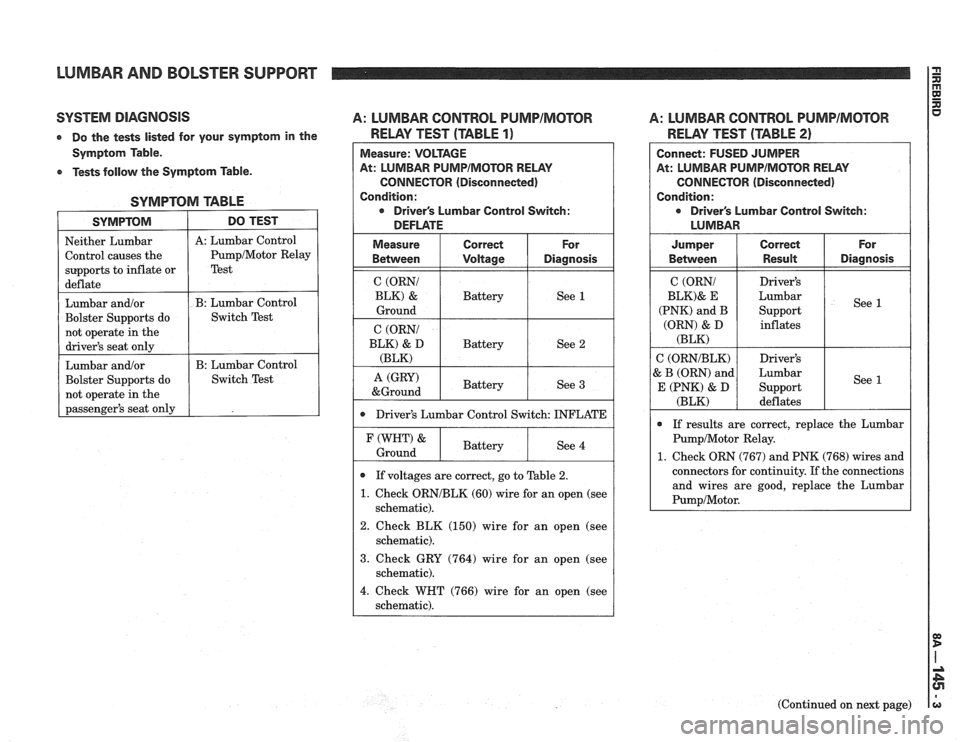
LUMBAR AND BOLSTER SUPPORT
SYSTEM DIAGNOSIS A: LUMBAR CONTROL PUMPIMCITOR A: LUMBAR CONTROL PUMPIMOTOR
At: LUMBAR PUMPIMOTOR RELAY
CONNECTOR (Disconnected)
Driver's Lumbar Control Switch:
0 Driver's Lumbar Control Switch: INFLAT
0 If voltages are correct, go to Table 2.
1. Check ORNIBLK (60) wire for an open (see
schematic).
2. Check BLK (150) wire for an open (see
schematic).
3. Check GRY (764) wire for an open (see
schematic).
4. Check WHT (766) wire for an open (see
schematic).
e Do the tests listed for your symptom in the RELAY TEST (TABLE 1)
Symptom Table.
e Tests follow the Symptom Table.
SYMPTOM TABLE
SYMPTOM
Neither Lumbar
Control causes the
supports to inflate or
deflate
Lumbar and/or
Bolster Supports do
not operate in the
driver's seat only
Lumbar
and/or
Bolster Supports do
not operate in the
passenger's seat only
RELAY TEST (TABLE 2)
DO TEST
A: Lumbar Control
PumpIMotor Relay
Test
B: Lumbar Control
Switch Test
B: Lumbar Control
Switch Test
(Continued on next page)
Connect: FUSED JUMPER
At: LUMBAR
PUMPIMOTOR RELAY
CONNECTOR (Disconnected)
Condition:
e Driver's Lumbar Control Switch:
LUMBAR
For
Diagnosis
See 1
See 1
Jumper
Between
C (ORNI
BLK)& E
(PNK) and B
(ORN) & D
(BLK)
C (ORNIBLK)
& B (ORN) and
E (PNK) & D
(BLK)
0 If results are correct, replace the Lumbar
PumpIMotor Relay.
1. Check ORN (767) and PNK (768) wires and
connectors for continuity. If the connections
and wires are good, replace the Lumbar
PumpIMotor.
Correct
Result
Driver's
Lumbar Support inflates
Driver's
Lumbar Support deflates
Page 1558 of 1825
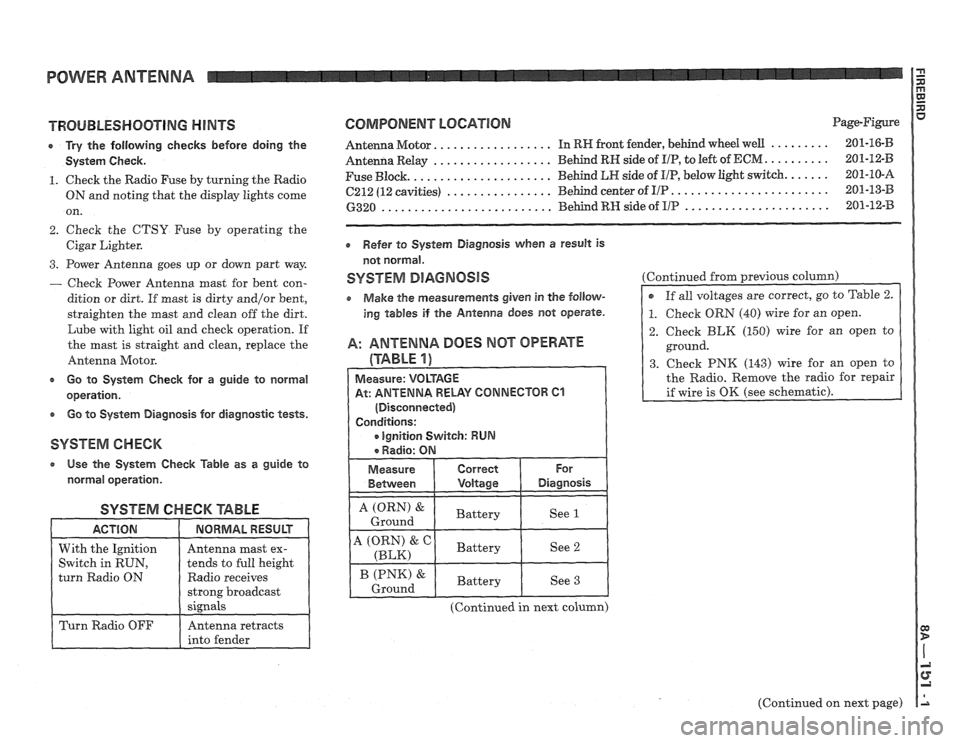
POWER ANTENNA
TROUBLESHOOTING HINTS
r Try the following checks before doing the
System Check.
1. Check the Radio Fuse by turning the Radio
ON and noting that the display lights come
on.
2. Check the CTSY Fuse by operating the
Cigar Lighter.
3. Power Antenna goes up or down part way
- Check Power Antenna mast for bent con-
dition or dirt. If
mast is dirty and/or bent,
straighten the mast and clean off the dirt.
Lube with light oil and check operation. If
the mast is straight and clean, replace the
Antenna Motor.
c Go to System Check for a guide to normal
operation.
e Go to System Diagnosis for diagnostic tests.
SYSTEM CHECK
a Use the System Check Table as a guide to
normal operation.
SYSTEM CHECK '6ABLE
Radio receives
COMPONENT LOCATION Page-Figure
................. ......... Antenna Motor. In RW front fender, behind wheel well 201-16-B
.................. .......... Antenna Relay Behind RN side of I/P, to
left of ECM 201-12-B
..................... ...... Fuse Block. Behind LR side
of UP, below light switch. 201-10-A
........................ ................ 6212 (12 cavities) Behind center of I/P 201-13-B
...................... .......................... 6320 Behind RH side of IIP 201-12-33
Refer to System Diagnosis when a result is
not normal.
SYSTEM DlAGNOSlS
o Make the measurements given in the follow-
ing tables if the Antenna does not operate.
A: ANTENNA DOES MOT OPERATE
(TABLE 1)
At: ANTENNA RELAY CONNECTOR 61
(Continued in next column) Continued
from previous
column)
2. Check BLK (150) wire for an open to
ground.
3. Check PNK (143) wire for an open to
the Radio. Remove the radio for repair
(Continued on next page)